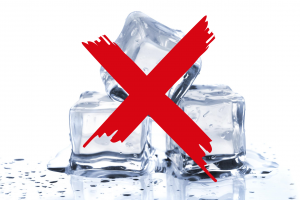As far back as I can remember, I have used the recovery protocol R.I.C.E. for my acute injuries. And, it was part of the curriculum of the massage therapy program I completed in 2002, then taught for 9 years at the same massage school.
The acronym R.I.C.E. stands for Rest, Ice, Compression, and Elevation. With recent research, it shows it may no longer be the best protocol to follow.
R.I.C.E. was the acronym for the standard of care for treating soft tissue injuries, and coined by Dr. Mirkin, the author of The Sportsmedicine Book (1978). Over the following 30 plus years, most everyone, from athletic trainers, physical therapists, massage therapists, and general practitioners, followed this protocol. However, recent research has proven that ice and rest, in regards to acute injuries, is less effective, and can actually delay the healing process.
“When I wrote my best-selling Sportsmedicine Book in 1978, I coined the term RICE (Rest, Ice, Compression, Elevation) for the treatment of athletic injuries (Little Brown and Co., page 94). Ice has been a standard treatment for injuries and sore muscles because it helps to relieve pain caused by injured tissue. Coaches have used my “RICE” guideline for decades, but now it appears that both Ice and complete Rest may delay healing, instead of helping.
*Read Dr. Mirkin’s blog post on his website on how ice delays healing.
Additional notable information from Dr. Mirkin:
New Acute Injury Protocol
New research suggests MEAT as the new protocol for acute injuries, replacing RICE
M.E.A.T. is the acronym for Movement, Exercise, Analgesia, and Treatment.
Movement – Following confirmation from your health care provider that movement will not further damage your injured area, it’s good to proceed to moving the area to kickstart the healing processes. Movement aids in circulation and helps to reduce adhesions.
Exercise – Assuming that you do not aggravate your injury further, and after the acute stage of the injury has passed, strengthening exercises of the affected area can have an effect of providing some pain relief.
Analgesia – Analgesics are products that decrease pain you feel. Natural products, like Raw Heat, that contain the ingredients menthol and wintergreen oil, can reduce the sensations of pain topically, and will not interfere with the natural processes of healing.
Treatment – Specific treatments designed to alleviate pain, and increase circulation and improve range of motion may accelerate the healing process of the injured area. Thus, massage and bodywork fits in very well when considering treatment for injuries.
As a bodywork therapist of more than 20 years, I have stopped using ice on my hands and forearms after a long day of bodywork therapy. Since switching to moist heat wraps, I recover quicker, and have less discomfort throughout my work week. One thing is clear: I’ll never miss the 10 minute ice soaks I used to do with my hands.





